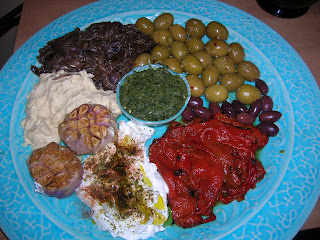The menu:
Sepharic "Antipasto"
Matza ball soup
Horseradish potatos
Roasted veggies with Yemeni Hawaiig
Druze eggplant-garbanzo stew
Roasted lamb with herbs d'provence
Roasted duck with blood orange sauce (via the in-laws)
Roasted chicken
Haddock with za'atar-tomato relish
Espresso toffee
Lemon-ginger cheesecake
Chocolate covered apricots
Ubiquitous ring-gels
Sholeh zard (Iranian rice pudding)
We started the evening with an "antipasto" of roasted peppers, caramelized onions, hummus, labneh & za'atar, roasted garlic, and assorted olives.

Roasted Red Peppers. I am not a fan of peppers- they're right up there with cilantro and hazelnuts for me- but as my husband put it, color theory overran taste. And everything else was sort of brownish-white on the plate. So, I cut and de-seeded them, then roasted them at 450, 15 minutes on each side with a little vegetable oil. It was a total annoyance to peel off the skins once they cooled, but there were no peppers left at the end of the night, so I suppose they went over well.
One cannot overrate caramelized onions. A few months ago, I was given leftover onions from a staff lunch at school by a colleague who knows that my hesitance to throw food out borders on the obsessive. So, I caramelized four frying pans worth of onions. We served them to guests on pasta, olive bread, omelettes, and anything that wasn't dessert. Although, would they be awful with mascarpone? Caramelizing onions takes about an hour. I throw them in the pan with a little olive oil and a little salt, and stir once in a while over medium heat. When they start to get mushy, after about 45 minutes, I sprinkle balsamic vinegar over the mix and cook, stirring, about 15 more minutes.
I made Quinoa-sweet potato cakes & cumin-orange raita again. They were particularly good- I cooked the quinoa with a cinnamon stick this year.

Horseradish roasted potatoes are a Passover favorite. We had particularly pungent horseradish this year! I chopped and roasted the potatos with olive oil, rosemary, and kosher salt. When they were crusty on the outside and soft on the inside (the magical potato combination), I took them out and added a few tablespoons of horseradish, adding spice and bite.
My favorite place to shop in Israel was the grocery store. I picked up za'atar and a Yemeni spice called Hawaiig. When I googled it for recipes, I got "Did you mean Hawaiian recipes?" Indeed, I did not. So I went rogue and just used it to roast veggies- carrots and parsnips. It was tasty! Here's what's in Hawaiig, or Hawayil:
3 teaspoons black peppercorns
1 1/2 teaspoons of caraway seeds
1/2 teaspoon of saffron threads
1/2 teaspoon of cardamom seeds
1 teaspoon of turmeric
The Druze eggplant stew was an improvisation. One of the best meals we had in Israel was in the Druze village of Ussefiyya. While I couldn't replicate the Druze pita, which is made on a convex black grill about 3 feet across, the stew I could handle. I based the recipe on one for Persian eggplant stew, but left out the chicken, added chick peas, and cooked it for much longer to get rid of that rubbery eggplant texture. It was excellent with a bit of labneh, a thick yogurt, and some people even mixed in the horseradish potatos.

Fish with za'atar tomato relish. I will admit that I based much of the seder meal this year on za'atar, my new obsession and a wonderful blend of the herb hyssop and sesame seeds. I bought some dried and my wonderful friend Reuven picked some fresh for me on a cave hike. The fish recipe was wonderful. I substituted haddock for the expensive, strong-tasting red snapper in the recipe.
Lemon-ginger cheesecake with almond crust. This lovely recipe is from Epicurious, via Smitten Kitchen. I added almond extract to the crust to make it more flavorful. I also added a teaspoon of powdered ginger, and topped it (after baking and cooling) with crystallized ginger. I think it would also be lovely with lavender, and candied lavender or violets on top...

Espresso toffee. I usually make this toffee recipe with lavender. Mom hates lavender and so last year I made with rosemary. Dad hates rosemary. But everyone likes coffee! I let it cook just a few seconds too long and it burned, creating a bitter, dark strip through the layers. It was fantastic! You could also melt chocolate and spread it on top.
1 stick butter
1 cup sugar
1/2 tsp salt
1/4 cup water
1 tbsp instant espresso
2 tsp molasses (optional)
Candy thermometer (essential!)
Butter a medium cookie sheet. Bring all ingredients to a boil. Put candy thermometer in and stir constantly 15-20 minutes until candy reaches hard crack stage- 300 F. Watch carefully! At 300 exactly, remove from heat. Pour onto baking sheet and let spread. Let it cool. Let it cool completely in the fridge and then break into pieces and serve. Keeps well in fridge!
Sholeh Zard. This amazing Iranian rice pudding was an lovely, exotic addition to the dessert menu. It took much, much longer than the above linked recipe indicates for the rice to soak up the 8 cups of water- which makes sense, since that's about 6 cups more water than you'd usually use to cook rice. I found saffron a the local Indian market for about six dollars, which is not bad, considering it's generally more expensive than gold. I also used orange blossom water instead of rosewater, which gave it a similarly flowery taste, but a little less soapy. It was a lovely, unusual dessert. The rice cooks down to a pudding-y texture and it's a dramatic yellow, due to the saffron.



